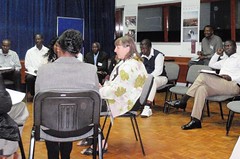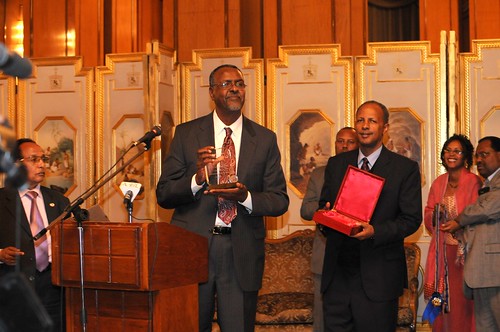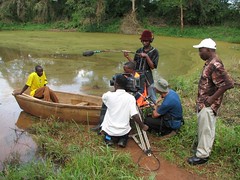An ASARECA-funded Napier grass smut and stunt resistance project held its final workshop on 2 and 3 June 2010 at the International Livestock Research Institute (ILRI), in Addis Ababa, Ethiopia. It gathered 30 participants from Kenya, Tanzania, Uganda, UK, and Ethiopia.
During the workshop, participants shared three main ways to tackle these diseases that attack an important feed for cattle: One is to identify alternative forage species. The second is to raise awareness of the disease and better management methods among farmers. The third is to control the vectors causing the diseases or to breed disease-resistant grasses.
It all started in 2007, when ASARECA – the Association for Strengthening Agricultural Research in Eastern and Central Africa, the International Livestock Research Institute, Rothamsted Research, Kenya Agriculture Research Institute, National Agricultural Research Organisation (Uganda) and the National Biological Control Programme (Tanzania) launched a three year project to examine the problems.
The project brought together scientists from national and international institutes to find ways to halt the spread of the diseases that affect Napier grass – an important feed source for dairy cattle in the region.
The project aimed to determine the extent of the disease problem in areas where smallholder dairy is important, to collect Napier grass clones that farmers select as more resistant to the diseases and to identify best management practices used by farmers to reduce the impact of the diseases.
With the vision and financial support of ASARECA, this project has characterized Napier grass clones, developed diagnostic techniques for use in the region, and formed local partnerships to share information and management practices.
During the two day meeting, participants set out different approaches to fight the disease. One is to identify other alternative forage species.
“Before we were growing Guatemala grass, says Peter Ddaki, workshop participant and farmer in Kitenga, Uganda. It was less tasty and hard to cut but we could go back to it because if this disease is not fought, we go to poverty”. “It is true violence to me”, he adds. “From my cows, I have three things: urine, milk and manure. Well, they have all reduced. My suggestion to researchers is to think about Guatemala grass or other forages in case Napier grass dies away.”
Jolly Kabirizi, senior researcher at the National Livestock Resources Research Institute (NaLIRRI) and project partner from Uganda is one of several researchers in the region looking more closely at other forages, such as the Brachiaria hybrid cv Mulato, and investigating feeding with crop residues. Jean Hanson, ILRI Forage diversity team leader, explains: “In this project we made the choice to focus on Napier grass and looked for a disease resistant variety of the same species because it is very difficult to find anything as productive as Napier and for farmers to change to other grasses for cut and carry systems. Guatemala grass does not have the same palatability as Napier grass, and Brachiara Mulato produces less biomass. We also carried on with research on Napier because its dissemination with cuttings is much easier than with the other grasses.”
Another approach is to raise awareness among farmers. Presentations showed that in the districts where the diseases were studied, over 80% of the farmers are now aware of the disease symptoms and adopt recommended best management practices. The incidence and severity of stunt especially, is really dropping (decline of 20 to 40% in Uganda and Kenya, more in Tanzania where it is an emerging disease) even though there is still a need to raise awareness to avoid spreading the disease. As Peter Ddaki puts it “don’t leave supervision of your garden to children or people who don’t know about the disease; use clean material when planting, or stunt will wipe out your entire crop.”
In Uganda, manure application seems to be the most effective control measure as it reduces Napier stunt incidence but also improves fodder yield. Similarly, in Tanzania and Kenya, a critical research area is the development of Integrated Pest Management.
A third approach is to look at the causes of the diseases and find ways to control the vectors or to breed disease-resistant grasses. Scientists from the International Centre of Insect Physiology and Ecology (ICIPE), Charles Midega and Evans Obura explained the importance of analyzing the biology of the disease and its vector. “Kenya is so far the only country where we identified a leafhopper vector (Maiestas (=Recilia) banda) transmitting Napier stunt disease”, says Evans Obura, Doctoral research fellow with ICIPE, “there could be other insects. We are at the moment working on identifying a phytoplasma (cause of the disease) resistant Napier grass cultivar and also studying the genetic diversity of Recilia banda in eastern Africa.”
But as Charles Midega pointed out: “if the resistant variety has high levels of resistance to the vector, where will the vector move to in the future? Food crops? And will food crops such as maize and millet be susceptible to phytoplasma?” This scary thought triggered numerous comments in the discussions.
On a positive note, Margaret Mulaa, senior researcher at the Kenya Agricultural Research Institute (KARI), has identified 28 clones that are not showing symptoms and appear disease resistant in the field in an area of high stunt incidence. These still need to be tested by farmers to confirm their yields and disease resistance before further distribution.
 Besides presentations, the workshop used participatory methods such as Fish Bowls and World cafes to encourage discussions. Facilitated with brio by Julius Nyangaga and Nadia Manning-Thomas, these lively sessions were sometimes new to participants and much appreciated. They particularly helped the project team interact with decision makers and regional stakeholders.
Besides presentations, the workshop used participatory methods such as Fish Bowls and World cafes to encourage discussions. Facilitated with brio by Julius Nyangaga and Nadia Manning-Thomas, these lively sessions were sometimes new to participants and much appreciated. They particularly helped the project team interact with decision makers and regional stakeholders.
It was clear from the group discussions that the project created awareness, trained scientists, mentored graduate students, plus identified materials and set up efficient networks.
Alexandra Jorge, Coordinator of the Global Public Goods Project, commented on the progress made in the three year project: “It is amazing to see the amount of knowledge people have accumulated when you compare the first meeting I attended in 2007 and this one! I also notice the ownership and commitment participants feel about their work” and she adds “I was impressed with how much people involved did at all levels in only three years…”
In her closing remarks, Sarah Mubiru from ASARECA shared a story illustrating the power of collaboration: In her story, a man brought to God asks to see Hell and Heaven. In Hell, people have bowls of soup but spoons that are too long to drink with or eat from. In Heaven, people with the same bowls and long spoons feed each other. The first results in chaos, the second in harmony.
She said that ASARECA similarly prides itself on its partnerships, carrying out fruitful partner-based research that improves livelihoods. ASARECA funds projects that “work locally” and have regional impact through linkages and dissemination.
She concluded that this project has achieved that goal with strong national teams addressing local issues, working together across the region to support each other and using the website to make the project results available world wide.
These sentiments were reflected by ILRI Theme Director Shirley Tarawali: “The strong collaborative nature of this project will hopefully last after the end of the project”.
More:
View presentations, posters, reports and outputs from the workshop and the project
Read an article by Nadia Manning-Thomas on the knowledge sharing processes used in the workshop






.jpg)


